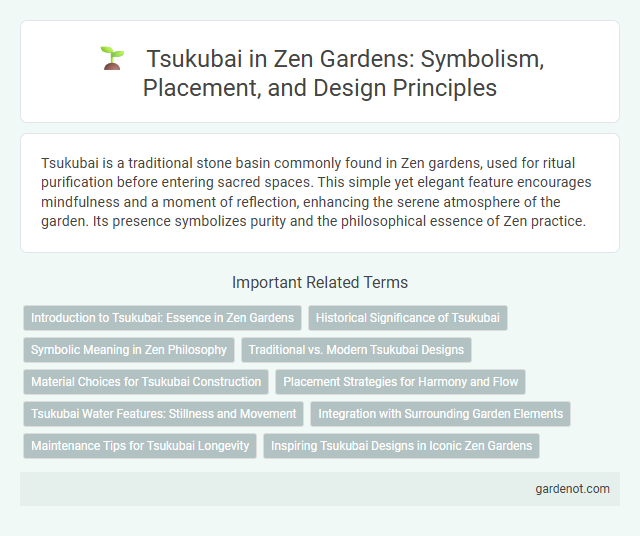Tsukubai is a traditional stone basin commonly found in Zen gardens, used for ritual purification before entering sacred spaces. This simple yet elegant feature encourages mindfulness and a moment of reflection, enhancing the serene atmosphere of the garden. Its presence symbolizes purity and the philosophical essence of Zen practice.
Introduction to Tsukubai: Essence in Zen Gardens
Tsukubai, a traditional stone water basin, embodies the essence of Zen gardens by symbolizing purity and humility. Used for ritual cleansing before entering sacred spaces, it encourages mindfulness and a moment of reflection. Its simple, natural design integrates seamlessly with the surrounding garden, enhancing the serene atmosphere fundamental to Zen aesthetics.
Historical Significance of Tsukubai
Tsukubai, a traditional stone basin found in Japanese Zen gardens, holds deep historical significance as it was originally used in tea ceremonies to wash hands and rinse mouths, symbolizing purification and humility. Its design emphasizes simplicity and mindfulness, reflecting Zen Buddhist principles that date back to the Muromachi period (1336-1573). The placement and use of Tsukubai illustrate the cultural importance of ritual cleansing within the context of Japanese spirituality and aesthetics.
Symbolic Meaning in Zen Philosophy
The Tsukubai, a stone basin in Zen gardens, symbolizes humility and purification, encouraging visitors to bow and cleanse themselves before entering sacred spaces. Its design reflects the Zen principle of simplicity and the importance of self-reflection, fostering mindfulness and spiritual renewal. This element embodies the practice of letting go of ego, preparing the mind for meditation and deeper awareness.
Traditional vs. Modern Tsukubai Designs
Traditional Tsukubai designs in Zen gardens emphasize natural materials such as stone basins and bamboo ladles, reflecting simplicity and wabi-sabi aesthetics. Modern Tsukubai variations integrate sleek, minimalist lines and alternative materials like metal or concrete, blending contemporary artistry with spiritual symbolism. Both styles serve the ritual of purification but differ significantly in visual and tactile experience, highlighting evolving interpretations of Zen principles.
Material Choices for Tsukubai Construction
Tsukubai in Zen gardens are traditionally crafted from natural stones such as granite, basalt, or andesite, chosen for their durability and weather resistance. The texture and color of these stones enhance the garden's aesthetic harmony, reflecting simplicity and tranquility. Selecting stones sourced locally not only supports sustainability but also ensures the tsukubai blends seamlessly with the surrounding environment.
Placement Strategies for Harmony and Flow
Tsukubai placement in a Zen garden is crucial for achieving harmony and flow by positioning it near pathways or entrances to invite mindful cleansing. Strategic alignment with natural elements like stones and plants ensures seamless integration within the garden's organic layout. Proper elevation and orientation maintain balanced water circulation, enhancing the tranquil atmosphere essential to Zen design.
Tsukubai Water Features: Stillness and Movement
Tsukubai water features in Zen gardens embody the harmonious blend of stillness and movement, reflecting tranquility and subtle energy flow. The gentle flow of water over stone basins creates meditative sounds that enhance mindfulness and spiritual cleansing rituals. These elements symbolize purity and renewal, inviting visitors to engage in contemplative practices within the serene garden setting.
Integration with Surrounding Garden Elements
The tsukubai seamlessly integrates with surrounding garden elements by using natural stone basins that complement the earthy textures of moss, gravel, and bamboo. Its low height invites guests to pause and reflect, creating a harmonious transition between water features and sculpted plants. Strategic placement near pathways and lanterns enhances the tranquil flow, reinforcing the Zen garden's meditative ambiance.
Maintenance Tips for Tsukubai Longevity
Regular cleaning of the Tsukubai basin prevents algae buildup and maintains water clarity, essential for the garden's aesthetic appeal. Inspect and clear the bamboo spout (kakei) to ensure smooth water flow and avoid blockages that can damage the structure. Seasonal maintenance includes removing fallen leaves and debris while protecting the stone surface with a gentle brush and water, preserving the Tsukubai's longevity in a Zen garden.
Inspiring Tsukubai Designs in Iconic Zen Gardens
Tsukubai designs in iconic Zen gardens showcase meticulously crafted stone basins that embody simplicity and spiritual cleansing, often accompanied by bamboo ladles and natural water flow. These elements create a serene focal point that invites mindfulness and ritual purification, harmonizing with surrounding moss, rocks, and carefully raked gravel patterns. The integration of Tsukubai in Zen gardens reflects traditional Japanese aesthetics, emphasizing balance, tranquility, and the subtle interplay of natural textures.
Tsukubai Infographic

 gardenot.com
gardenot.com